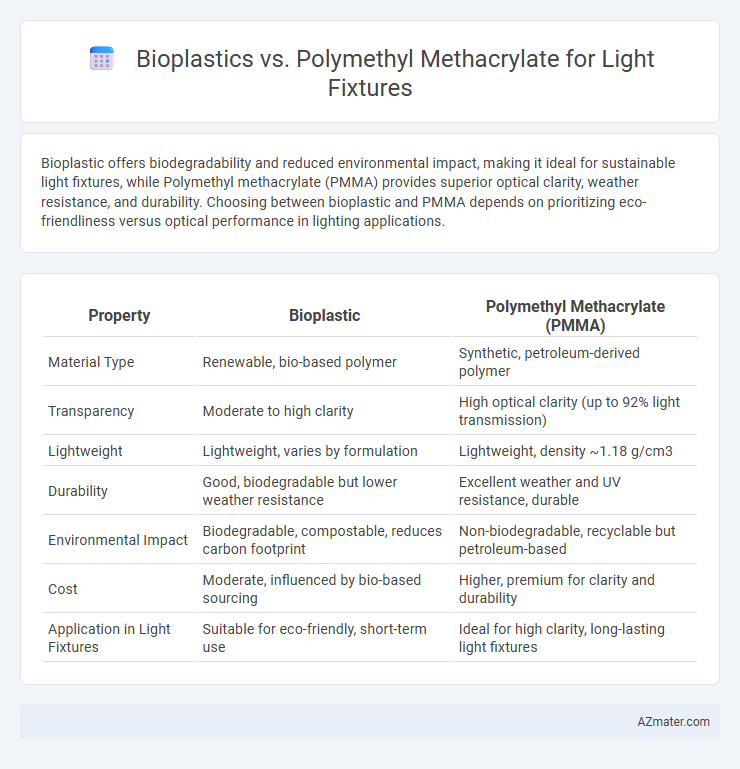Bioplastic offers biodegradability and reduced environmental impact, making it ideal for sustainable light fixtures, while Polymethyl methacrylate (PMMA) provides superior optical clarity, weather resistance, and durability. Choosing between bioplastic and PMMA depends on prioritizing eco-friendliness versus optical performance in lighting applications.
Table of Comparison
| Property | Bioplastic | Polymethyl Methacrylate (PMMA) |
|---|---|---|
| Material Type | Renewable, bio-based polymer | Synthetic, petroleum-derived polymer |
| Transparency | Moderate to high clarity | High optical clarity (up to 92% light transmission) |
| Lightweight | Lightweight, varies by formulation | Lightweight, density ~1.18 g/cm3 |
| Durability | Good, biodegradable but lower weather resistance | Excellent weather and UV resistance, durable |
| Environmental Impact | Biodegradable, compostable, reduces carbon footprint | Non-biodegradable, recyclable but petroleum-based |
| Cost | Moderate, influenced by bio-based sourcing | Higher, premium for clarity and durability |
| Application in Light Fixtures | Suitable for eco-friendly, short-term use | Ideal for high clarity, long-lasting light fixtures |
Introduction to Materials: Bioplastic and Polymethyl Methacrylate
Bioplastic, derived from renewable biomass sources such as corn starch or sugarcane, offers a sustainable alternative to conventional plastics with biodegradability and reduced environmental impact. Polymethyl methacrylate (PMMA), a synthetic polymer commonly known as acrylic, provides exceptional transparency, weather resistance, and light diffusion properties, making it ideal for light fixtures. The selection between bioplastic and PMMA for lighting applications depends on factors such as durability, optical clarity, environmental considerations, and manufacturing processes.
Environmental Impact: Bioplastic vs PMMA
Bioplastic offers a lower carbon footprint and biodegradability compared to Polymethyl methacrylate (PMMA), which is derived from fossil fuels and contributes to long-term plastic pollution. While bioplastics can decompose under industrial composting conditions, PMMA persists in the environment for centuries, intensifying landfill accumulation. However, PMMA provides higher durability and recyclability rates in certain controlled recycling streams, partially offsetting its environmental drawbacks relative to conventional plastics.
Material Properties Relevant to Light Fixtures
Bioplastic offers biodegradability and environmental sustainability, with moderate impact resistance and flexibility suitable for lightweight light fixture components. Polymethyl methacrylate (PMMA) exhibits superior optical clarity, high tensile strength, and excellent UV resistance, making it ideal for durable, transparent light covers and diffusers. PMMA's resistance to yellowing and superior light transmission efficiency outperform most bioplastics, ensuring long-lasting aesthetic and functional performance in light fixtures.
Light Transmission and Optical Clarity Comparison
Bioplastics generally offer moderate light transmission but typically fall short in optical clarity compared to polymethyl methacrylate (PMMA), which has superior transparency and light diffusion properties ideal for light fixtures. PMMA transmits up to 92% of visible light, providing crisp, clear illumination with minimal haze, whereas bioplastic materials usually exhibit lower transmission rates and higher haze levels due to their molecular structure. The choice between bioplastic and PMMA depends on balancing environmental sustainability with performance requirements in optical clarity and light transmission for lighting applications.
Durability and Lifespan in Lighting Applications
Bioplastics generally exhibit lower durability and shorter lifespan compared to polymethyl methacrylate (PMMA) in lighting applications due to their susceptibility to UV degradation and moisture absorption. PMMA offers superior weather resistance, high impact strength, and excellent optical clarity, making it ideal for long-lasting, high-performance light fixtures. The extended lifespan and robust durability of PMMA reduce maintenance needs and replacement frequency, ensuring better long-term value in lighting environments.
Design Versatility and Aesthetic Possibilities
Bioplastic offers design versatility through its moldability and range of colors, making it suitable for eco-friendly light fixtures with unique textured finishes. Polymethyl methacrylate (PMMA) provides superior clarity and a smooth, glossy surface, enabling sleek, modern aesthetic possibilities with excellent light diffusion and UV resistance. While bioplastics emphasize sustainability and varied forms, PMMA excels in durability and premium transparency for high-end lighting designs.
Manufacturing Processes and Cost Considerations
Bioplastic for light fixtures involves renewable raw materials such as starch or cellulose, often processed through extrusion or injection molding, offering lower environmental impact but typically higher raw material costs compared to conventional plastics. Polymethyl methacrylate (PMMA) is manufactured predominantly via bulk or solution polymerization, followed by molding or casting, ensuring superior optical clarity and durability at a relatively stable production cost. Cost considerations reveal bioplastics may have higher variability due to biomass sourcing and processing complexities, while PMMA benefits from established supply chains and economies of scale, making it generally more cost-effective for large-scale light fixture production.
Fire Safety and Thermal Resistance
Polymethyl methacrylate (PMMA) offers superior fire safety and thermal resistance compared to many bioplastics, with a higher ignition temperature around 460degC and self-extinguishing properties crucial for light fixture applications. Bioplastics, often derived from renewable sources like polylactic acid (PLA), generally have lower thermal stability and can ignite at temperatures between 200-300degC, posing increased fire hazards. Selecting PMMA enhances durability and safety in lighting, especially in environments requiring rigorous fire resistance standards.
End-of-Life Scenarios: Recycling and Biodegradability
Bioplastics used in light fixtures offer enhanced biodegradability, enabling natural decomposition under industrial composting conditions, whereas polymethyl methacrylate (PMMA) primarily relies on mechanical recycling processes due to its thermoplastic properties. End-of-life PMMA is typically collected via specialized recycling streams where it is reprocessed into pellets for new applications, helping reduce landfill waste but not biodegrading. Bioplastic fixtures, however, can reduce environmental impact through industrial composting or anaerobic digestion, providing an eco-friendly disposal alternative that PMMA lacks.
Future Trends in Sustainable Light Fixture Materials
Bioplastics offer promising advancements in sustainable light fixture materials due to their biodegradability and reduced carbon footprint compared to traditional polymers like polymethyl methacrylate (PMMA), which remains popular for its durability and optical clarity. Emerging bioplastic composites are being engineered to match PMMA's mechanical and aesthetic properties while enhancing environmental compatibility. Future trends emphasize the integration of bio-based resins and recycled content to create light fixtures with superior sustainability credentials without sacrificing performance or design flexibility.

Infographic: Bioplastic vs Polymethyl methacrylate for Light fixture
 azmater.com
azmater.com